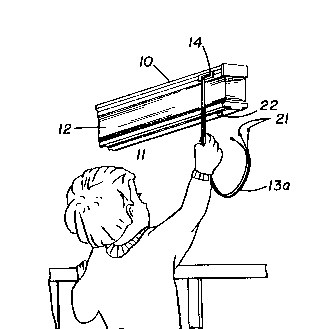Some of the information on this Web page has been provided by external sources. The Government of Canada is not responsible for the accuracy, reliability or currency of the information supplied by external sources. Users wishing to rely upon this information should consult directly with the source of the information. Content provided by external sources is not subject to official languages, privacy and accessibility requirements.
Any discrepancies in the text and image of the Claims and Abstract are due to differing posting times. Text of the Claims and Abstract are posted:
| (12) Patent Application: | (11) CA 2142059 |
|---|---|
| (54) English Title: | WINDOW SHADE WITH BREAK-AWAY ATTACHMENT OF LIFT CORDS TO BOTTOM RAIL |
| (54) French Title: | STORE POUR FENETRE AVEC DISPOSITIF DE SECURITE POUR LES ENFANTS |
| Status: | Deemed Abandoned and Beyond the Period of Reinstatement - Pending Response to Notice of Disregarded Communication |
| (51) International Patent Classification (IPC): |
|
|---|---|
| (72) Inventors : |
|
| (73) Owners : |
|
| (71) Applicants : |
|
| (74) Agent: | SMART & BIGGAR LP |
| (74) Associate agent: | |
| (45) Issued: | |
| (22) Filed Date: | 1995-02-08 |
| (41) Open to Public Inspection: | 1995-10-01 |
| Availability of licence: | N/A |
| Dedicated to the Public: | N/A |
| (25) Language of filing: | English |
| Patent Cooperation Treaty (PCT): | No |
|---|
| (30) Application Priority Data: | ||||||
|---|---|---|---|---|---|---|
|
A window shade assembly comprising a header, a bottom
rail and expansible and contractable shade means attached
to the header and bottom rail, and lift cords attached to
the bottom rail and extending upwardly to the header and
through a cord lock on the header and having lift cord
operating portions extending downwardly from the cord lock
means for raising and lowering the bottom rail, the lower
ends of the operating portions of the lift cords are
detachably mounted on the bottom rail to be raised and
lowered with the bottom rail to reduce cord dangle and the
detachable mounting is arranged to allow the lower end of
the operating portion of each lift cord to detach from the
bottom rail and separate from the operating portions of
the other lift cords when the lower end of the lift cord
is subjected to a tensile force in a direction away from
the bottom rail, for child safety reasons.
Note: Claims are shown in the official language in which they were submitted.
Note: Descriptions are shown in the official language in which they were submitted.

2024-08-01:As part of the Next Generation Patents (NGP) transition, the Canadian Patents Database (CPD) now contains a more detailed Event History, which replicates the Event Log of our new back-office solution.
Please note that "Inactive:" events refers to events no longer in use in our new back-office solution.
For a clearer understanding of the status of the application/patent presented on this page, the site Disclaimer , as well as the definitions for Patent , Event History , Maintenance Fee and Payment History should be consulted.
| Description | Date |
|---|---|
| Inactive: IPC from MCD | 2006-03-11 |
| Inactive: IPC from MCD | 2006-03-11 |
| Time Limit for Reversal Expired | 1999-02-08 |
| Application Not Reinstated by Deadline | 1999-02-08 |
| Deemed Abandoned - Failure to Respond to Maintenance Fee Notice | 1998-02-09 |
| Letter Sent | 1997-06-18 |
| Reinstatement Requirements Deemed Compliant for All Abandonment Reasons | 1997-06-09 |
| Inactive: Adhoc Request Documented | 1997-02-10 |
| Deemed Abandoned - Failure to Respond to Maintenance Fee Notice | 1997-02-10 |
| Application Published (Open to Public Inspection) | 1995-10-01 |
| Abandonment Date | Reason | Reinstatement Date |
|---|---|---|
| 1998-02-09 | ||
| 1997-02-10 |
The last payment was received on 1997-06-09
Note : If the full payment has not been received on or before the date indicated, a further fee may be required which may be one of the following
Please refer to the CIPO Patent Fees web page to see all current fee amounts.
| Fee Type | Anniversary Year | Due Date | Paid Date |
|---|---|---|---|
| Reinstatement | 1997-06-09 | ||
| MF (application, 2nd anniv.) - standard | 02 | 1997-02-10 | 1997-06-09 |
Note: Records showing the ownership history in alphabetical order.
| Current Owners on Record |
|---|
| SPRINGS WINDOW FASHIONS DIVISION, INC. |
| Past Owners on Record |
|---|
| JOHN R. GENOVA |